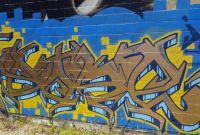
There is a memorable scene in the iconic 1983 graffiti documentary Style Wars in which then New York Mayor Ed Koch discusses his plan for wild wolves to patrol and defend the city’s subway train lay-up yards from graffiti writers. While it seems over the top, it highlights an extreme of the various approaches to graffiti deterrence undertaken by municipalities over the years, constantly exploring ways of eradicating the writing on the wall (not to mention the more blood-thirsty plans of public commentators, who have been known to call for dismemberment or worse).
Responses to the problem of graffiti vandalism include the practical removal with swathes of grey or brown paint (a dubious aesthetic improvement), surveillance of areas, restricted access to aerosol paint and even attempts to harness the creativity of artists in legal projects or spaces. Of course, graffiti is grounded in rebellious intent and thrives on existential challenges, and along with street art, tactical evolutions are constant; the anonymity of pseudonyms and changing identities, the intimate familiarity with targeted ‘spots’, and the portability of tools spring to mind. Graffiti continually reinvents aspects of its performance in counter response to the moves of authority.
Admittedly, the Christchurch City Council approach has evolved over time, utilising more discretion and recognising the complex balancing act of the city’s ongoing recovery and new-found urban art’s reputation. However, more traditional responses remain necessarily in place.
I was intrigued when the Council recently announced a new initiative to combat repeated graffiti vandalism. The media release explained the plan to map and track graffiti across Christchurch would use “innovative technology” and data from the public and contractors to help “identify repeat offenders to police.” While this is nothing new (and was presented in the standard “anti-social” rhetoric) the technology will utilise an “algorithmic identification technique” to match“ graffiti images that show key similarities.”
Programme manager Michael Healey proclaimed that: “With this new technology we will be able to connect a graffiti tag with an individual or ‘crew’.” Essentially, stylistically details would connect examples of graffiti and build a body of incriminations.
Distinctive personal style has long been central to graffiti, tied to the desire for recognition and respect. But it seems a difficult way to identify with certainty, especially with the tactical adaptability of graffiti writers. What would be considered a ‘key’ similarity? Wild-style graffiti is almost indecipherable to the uninitiated, intricate interlocking forms more concerned with the internal audience, often rendering stylistic traits variable. Similarly, while ‘biting’ or copying someone’s style is an offense, the internet era has made the spectrum of graffiti styles readily available and influential and less personally definitive. In a sense graffiti has become post-modern. What would stop imitation swaying from flattery to insincere or accidental incrimination?
The point here is to raise the uncertainties of such an approach and to suggest why it has proven so hard to eradicate graffiti despite decades of attempts. Graffiti thrives on opposition; it exists in opposition. Attempts to crack down on graffiti often result in new directions within the culture rather than its disappearance. In its pure form, graffiti is a game of sorts between writer and authority, although the role of cat or mouse is perhaps open to debate.
IMAGE
To the uninitiated, graffiti can seem indecipherable, making the recognition of style
